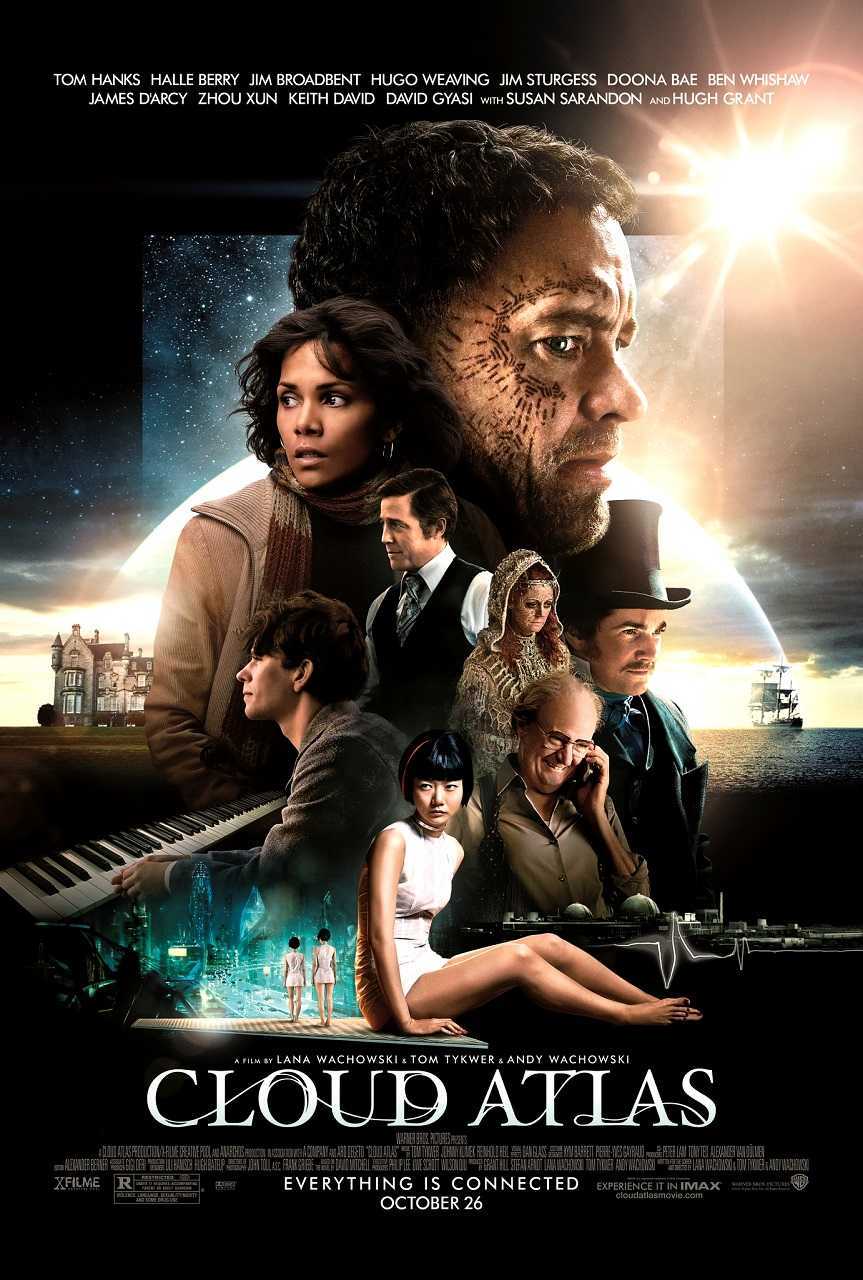USA/Germany/Hong Kong/Singapore. 2012.
Crew
Directors/Screenplay – Tom Tykwer, Andy Wachowski & Lana Wachowski, Based on the Novel Cloud Atlas (2004) by David Mitchell, Producers – Stefan Arndt, Grant Hill, Tom Tykwer, Andy Wachowski & Lana Wachowski, Photography – Frank Griebe & John Toll, Music – Reinhold Heil, Johnny Klimek & Tom Tykwer, Visual Effects Supervisor – Stephane Ceretti, Senior Visual Effects Supervisor – Dan Glass, Visual Effects – Arri FX (Supervisor – Dominik Trimborn), Bluebolt (Supervisor – Angela Barson), Exocet (Supervisor – Falk Gartner), Gradient Effects (Supervisor – Olcun Tan), Industrial Light and Magic (Supervisor – Russell Earl), Lola VFX (Supervisor – Clark Parkhurst), Method Studio London (Supervisor – Stephane Naze), Method Studios Los Angeles (Supervisor – Matt Dessero), Method Studio Vancouver (Supervisor – Geoffrey Hancock), One of Us (Supervisors – Tom Debenham & Dominic Parker), Rise FX, Scanline VFX (Supervisor – Rainer Zottl), Trixter (Supervisor – Alessandro Cioffi), Special Effects – Die Nefzers (Supervisor – Uli Nefzer), Makeup Design – Daniel Parker & Jeremy Woodhead, Production Design – Hugh Bateup & Uli Hanisch. Production Company – Cloud Atlas/X-Treme Creative Pool/Anarchos Pictures/Dreams of Dragons Pictures/Ascension Pictures.
Cast
Tom Hanks (Zachry Bailey/Dr Henry Goose/Isaac Sachs/Dermot Hoggins/Hotel Manager/Cavendish Look-a-Like Actor), Jim Broadbent (Timothy Cavendish/Vyvyan Ayrs/Captain Molyneux/Korean Musician/Prescient 2), Halle Berry (Luisa Rey/Meronym N’Fera/Jocasta Ayrs/Ovid/Indian Party Guest), Doona Bae (Somni-451/Tilda Ewing/Megan’s Mom/Mexican Woman/Sonmi-351/Sonmi Prostitute), Ben Whishaw (Robert Frobisher/Cabin Boy/Store Clerk/Georgette/Tribesman), Jim Sturgess (Adam Ewing/Hae-Joo Chang/Poor Hotel Guest/Megan’s Dad/Highlander/Zachry Brother-in-Law), Hugo Weaving (Haskell Moore/Nurse Noakes/Bill Smoke/Tadeusz Kesselring/Boardman Mephi/Old Georgie), James D’Arcy (Rufus Sixsmith/Archivist/Nurse James), Hugh Grant (Lloyd Hooks/Denholme Cavendish/Reverend Giles Horrox/Hotel Heavy/Seer Rhee/Kona Chief), David Gyasi (Autua/Lester Rey/Duophsyte), Keith David (Joe Napier/Kupaka/An-kor Apis/Prescient), Zhou Xun (Yoona-939/Talbot/Hotel Manager/Rose), Susan Sarandon (Madame Horrox/Older Ursula/Yusouf Suleiman/Abbess), Robert Fyfe (Mr Meeks/Old Salty Dog/Prescient 1), Brody Nicholas Lee (Javier Gomez/Jonas/Zachry’s Older Nephew)
Plot
1846, Adam Ewing is an American lawyer at sail in the South Pacific. On board the ship, he takes a stance to protect a stowaway slave. In 1931, Robert Frobisher is a neophyte composer who is hiding a life as a gay man. He goes to the great Vyvyan Ayrs who is aging and faded in his brilliance, offering his services as amanuensis, to see if he can make a name for himself by inspiring Ayrs to a new work. As the two begin collaborating on a symphony, Frobisher finds he is trapped in a deal he cannot escape from. San Francisco, 1973. Luisa Rey is a journalist who goes to interview Frobisher’s now aging lover, the physicist Rufus Sixsmith, only to arrive at his hotel room and find he has been shot. Beneath his body, she finds a packet of letters that set her on the trail of underhand dealings at the Swannekke nuclear power plant where Sixsmith was employed. However, this makes her a target that the company seeks to silence. England, 2012. Publisher Timothy Cavendish takes on the job of publishing the autobiography of gangster Dermot Hoggins, only to be pursued by Hoggins’s former colleagues wanting money. He appeals to his brother Denholme for help. Denholme agrees to place him in hiding in a hotel – only for Timothy to find that he has been committed to a nursing home for the elderly. Neo-Seoul, 2441. The fabricant Somni-451, genetically engineered for working as a functionary in the fast food franchise PapaSong, has been placed under arrest. She tells the story of her gradual awareness and defiance of the system, aided by the soldier Hae-Joo Chang. 106 years after The Fall. Zachry Bailey lives in a village with his tribe after civilisation has collapsed. Meronym arrives from afar and asks help in being guided up a mountain. Zachry agrees to do so but has visions that this will spell doom.
The duo that started out as The Wachowski Brothers (Andy and Larry Wachowski) are cult figures. (Following Larry’s post-op sex change, the duo are credited here for the first time as Andy and Lana Wachowski, while Andy subsequently underwent the operation to become Lilly). After writing several Clive Barker-based comic-books and the screenplay for Assassins (1995), they made their directing-writing debut with the thriller Bound (1997). They then went onto The Matrix (1999), which is maybe the single most influential genre film of the 00s. The Matrix created a cult with its unique action moves and visual effects that were rapidly copied everywhere, a cyberpunk fashion trend with Keanu Reeves’ raven-like black PVC, trenchcoat and shades look, and setting the benchmark for any subsequent film that dealt with Virtual Reality and reality-bending themes.
Following up such a groundbreaking and cult work is a hard task to do and the Wachowskis’ two sequels, The Matrix Reloaded (2003) and The Matrix Revolutions (2003), were greeted with howls of disappointment. The Wachowskis work outside of that has been uneven – they only directed one other film between The Matrix films and Cloud Atlas with Speed Racer (2008), a gorgeous candyfloss live-action recreation of the anime tv series that proved to be a critical and box-office flop. Outside of that, they wrote and produced the fine adaptation of Alan Moore’s V for Vendetta (2006) under director James McTeigue and produced McTeigue’s next film, the slickly exciting Ninja Assassin (2009), which met with general disappointment.
Here the Wachowskis have turned to the novel Cloud Atlas (2004) by British writer David Mitchell. The book was shortlisted for the Man Booker Prize in its year (although did not win) and has been called a masterpiece. A copy of the book was apparently given to The Wachowskis by Natalie Portman on the set of V for Vendetta and they immediately became fans and solicited a $140 million budget to conduct an adaptation.
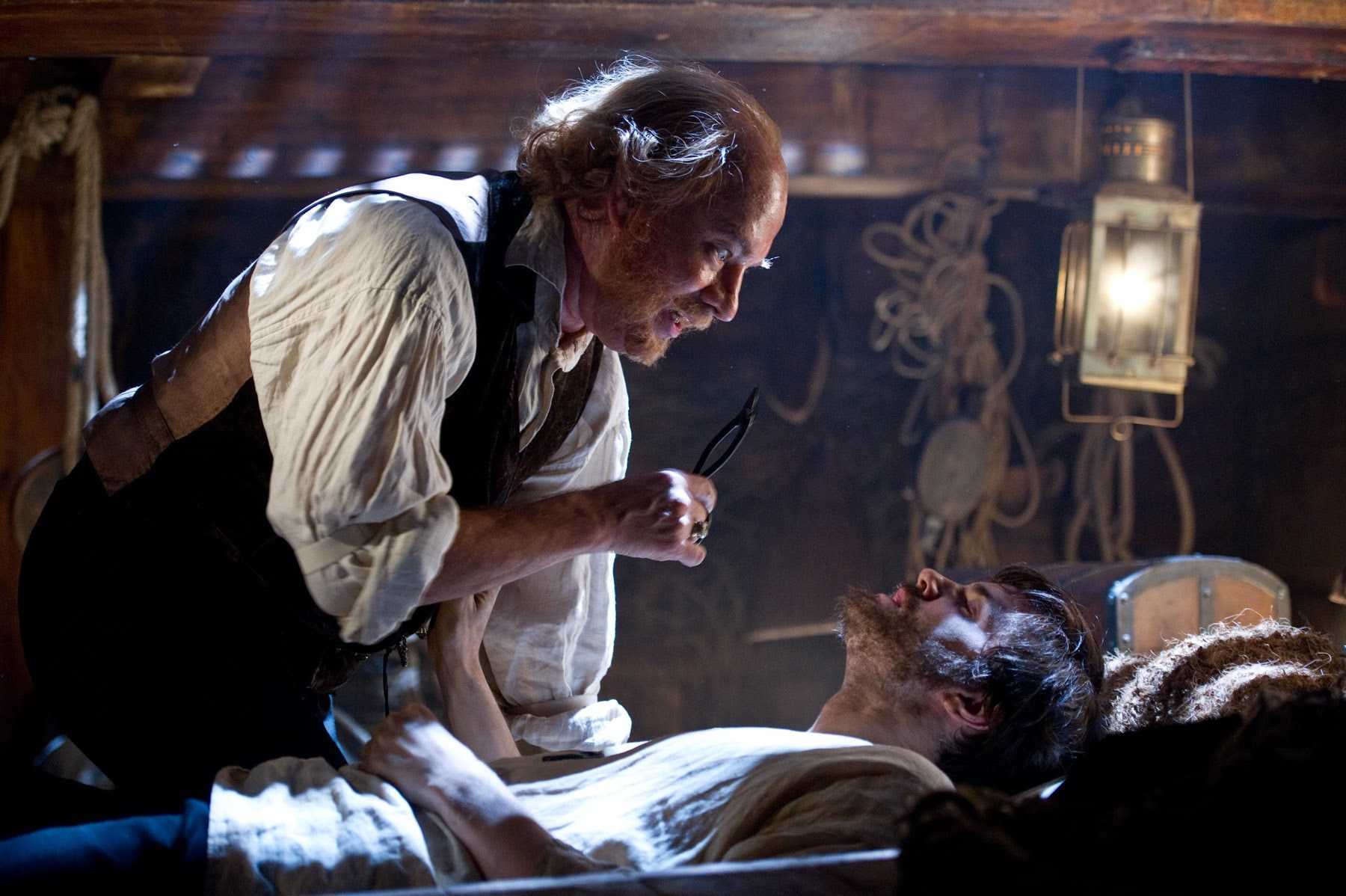
For the film version, the Wachowskis have teamed up with German director Tom Tykwer who has made the likes of Run Lola Run (1998), The Princess and the Warrior (2000), Heaven (2002), Perfume: The Story of a Murderer (2006), The International (2009) and A Hologram for the King (2016), which sounds like it should be a science-fiction film but isn’t. Tykwer and the Wackowskis divide the film between them – they shooting the futuristic segments and the Pacific Islands story, while Tykwer handles the 20th Century and contemporary stories. The film was principally shot in Germany (as well as several international locations) with all three directors filming simultaneously with actors moving between sets to play different roles in the various stories.
With Cloud Atlas, The Wachowskis have attempted to make an epic film that deals with the meaning of it all. They have never been ones to settle for chewing off anything less than a massive bite – tackling the nature of reality and reinventing the action film (The Matrix), taking modern society and the US to task politically (V for Vendetta), reinventing children’s anime as art (Speed Racer), reinventing the ninja film (Ninja Assassin), tackling the spectrum of modern sexuality (Sense8).
It seems mandatory for films seeking to be epic to have a script that covers multiple epochs of history, something that began with D.W. Griffith’s Intolerance (1916). The most famous of these, which the Wachowskis have acknowledged a direct debt of inspiration to, was 2001: A Space Odyssey (1968). Cloud Atlas copies much of Stanley Kubrick’s structure – multiple stories in different periods of time that only seem to tangentially overlap, before everything is tied together in an ending that grasps at cosmic-sized answers to it all. Although perhaps the film that Cloud Atlas resembles more than 2001 is The Fountain (2006) and its overlapping cross-historical story where the same actors played different roles in each era and each of the stories was connected in terms of symbols and mirrorings. Another comparison might be to Alejandro Gonzalez Innaritu’s non-genre Babel (2006) and its multiple story strands where aspects from one story influence the other without the characters being aware of it.
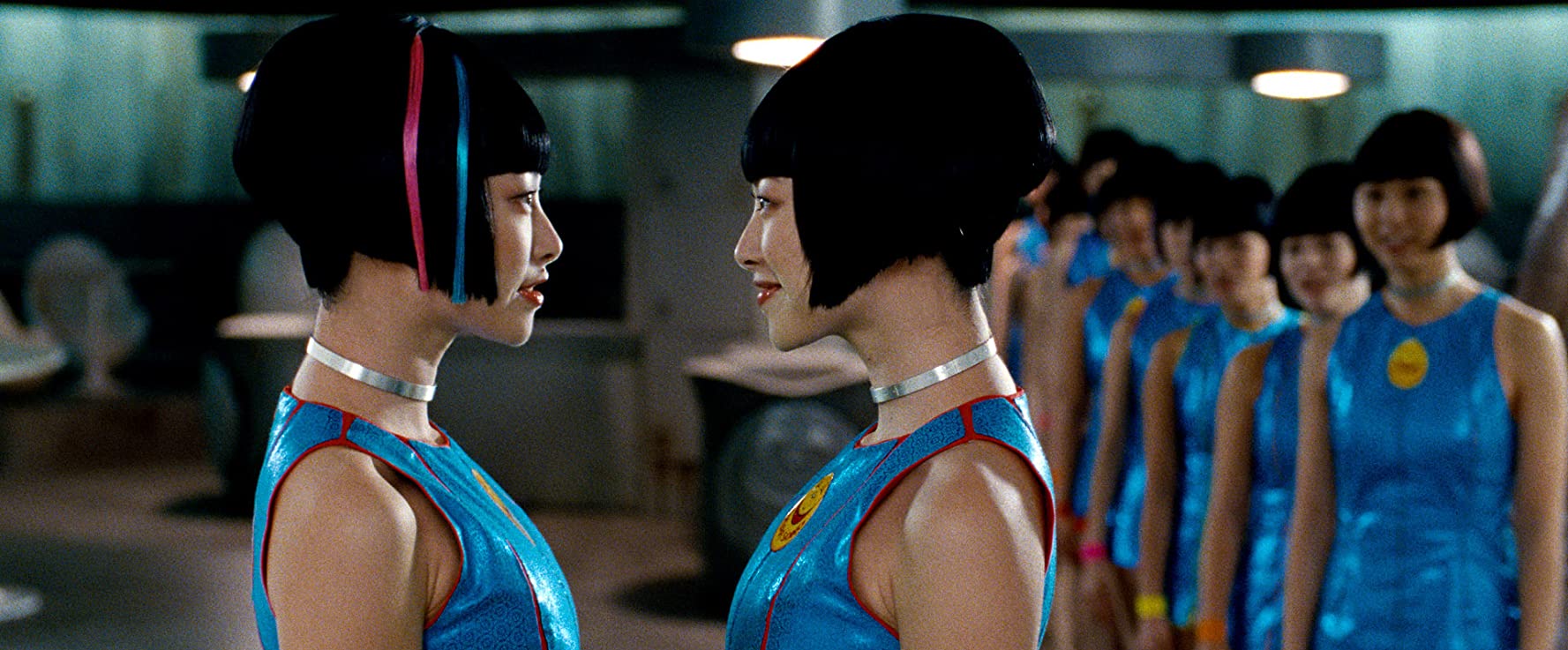
Rather than an epic journey into transcendental space a la 2001, the Wachowskis end the film on a utopian upsurge where they draw their stories together and attempt to make a statement on the meaning of it all – that love is the most important thing there is; that we are all connected; the Eastern sense of there being a pattern to life; the slight suggestion that there is an afterlife; and returning to their political leanings in favour of defying the social norm and standing up for what is right no matter the cost. The shuffling of the actors between roles is seen as a single soul’s evolution and journey representing the defiance of an unjust system across the ages.
Cloud Atlas must have been one of those films that studio publicists hate. Not unexpectedly, as the Wachowskis recount, the film proved a nightmare in terms of financing with many US studios backing off and they eventually finding the money independently with a large part of budget coming from the German Federal Fund – even so they were forced to defer their directors fees and sink their own money into the production.
For the greater part of its running time, this is a film that doesn’t seem to clearly be about anything. You can use abstract descriptions – a canvas of stories that covers different eras, connected themes about life, the evolution of the soul – but the connections are not always clear and are certainly not the easy pigeonholes that the studios like to push things into. This may well be why the Wachowskis broke their usual veil of secrecy – their unwillingness to be interviewed and a contractually stipulated refusal to engage in any of the publicity for their films – with they and Tom Tykwer making a three-minute interview clip where they tried to explain what the film was.
Cloud Atlas was called an epic but more than anything it feels like an uneven film that is propelled by its determination that people perceive it as an epic. Down on an individual level not all of the stories are that interesting. I look at each story and wonder how they would have stood up as individual films on their own. Equally, you look at the bigger picture and question whether the overarching structure of the story is strong enough to make the film work. (I suspect not, although the screenplay does wind things nicely together in soaring monologue by Doona Bae at the end).
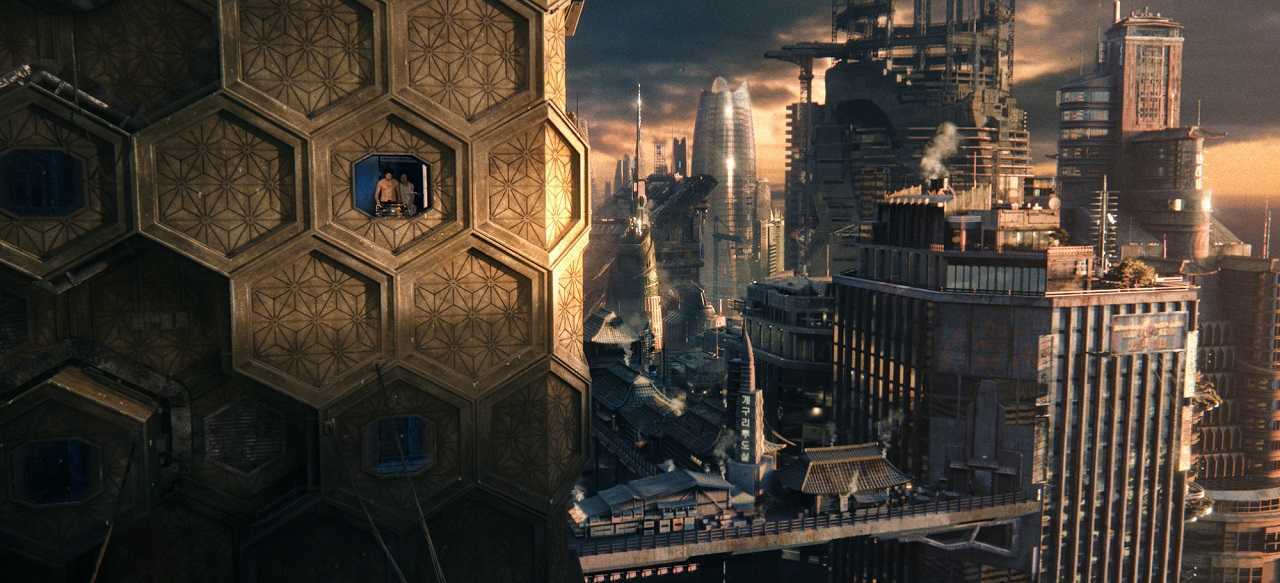
The film is at its most fun during Tom Tykwer’s segments – the 1931 segment and the present-day one – which are given life by Jim Broadbent’s irascible playing. The 1973 story with a depressed-looking Halle Berry fails to find anything exciting in its thriller plot. It feels like a whistleblower/corporate cover-up story that has been more substantially covered by other films. The South Pacific scenes are okay but one feels that what is going on on board the ship – especially when it comes to the character of Tom Hanks’ avaricious doctor – needed a longer running time to tell it. There is also the aspect about the birthmark, which in the book is meant to signify that the protagonists in each of the stories is the reincarnation of the other, but this is not made clear in the film.
Then there are the Wachowskis’ two segments that fall into science-fiction. The first of these (at least in terms of the film’s internal chronology) is the one set in Neo Seoul. This sets in with a blinding series of casually layered social assumptions that immediately make it seem a compulsively brilliant piece of science-fiction – the idea of people created as clones to serve in a McDonalds-styled corporate franchise of the future; seeing them treated as a sub-species; the idea of the fabricants being supplied a corporate religion akin to Logan’s Run (1976) where they are pacified by ideas of an afterlife to disguise the fact that they are being disposed of. The Wachowskis have fun littering tiny pieces of technology throughout – hover vehicles that ride on roads of light, portable insta-bridges, cubicle apartments with remote control furniture and window scapes and so on.
The disappointment of the segment is that soon after creating a fascinating world with so many ideas woven into it, The Wachowskis do nothing except conduct a standard story about lovers fleeing from a harsh authoritarian system. This is a story arc that has been done by too many dystopian works, while the latter half of the segment seems to only be an array of action and shootout scenes. Moreover, when the film ventures aboveground, the scenes of the city of the future would be impressive if the entire look had not been more impressively beaten out by Total Recall (2012) two months earlier.
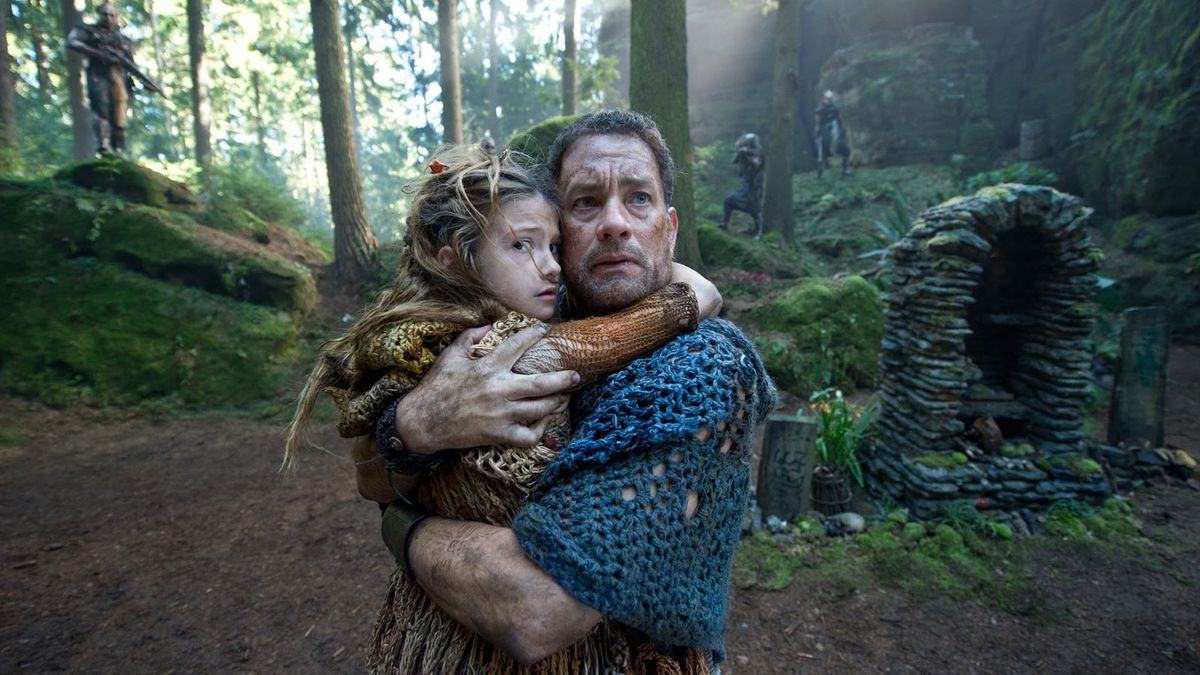
The sequence set ‘106 Years After the Fall’ is not much better. Here the Wachowskis have made the interesting choice of writing the entire segment in a future argot that is a decayed version of English. While this may be interesting, the upshot, like the science-fiction works of writer Jack Womack, feels like a story that takes place in a foreign language without the benefit of subtitles. Unlike the other stories, this segment never seems to build to much – it is never made clear what the purpose of the all-important journey to and the activation of the observatory on the top of the mountain serves.
One of the other features of the film is that actors turn up playing different characters in each of the segments. I am not sure if this serves any particular point other than allowing a curious game of spot the face behind the makeup. That said, some of the makeups on the actors are highly uneven. In particular, the makeup on some of the actors cast as Asians in the Neo-Seoul segment harkens back to the bad effect of Caucasians attempting to look like Asians that we had in the day of Charlie Chan movies. The actors and all the roles they play throughout are highlighted over the end credits and it surprises the audience seeing the number of guises, many of which you would not have guessed. The most fun transformation is seeing Tom Hanks in the contemporary segment playing a pugnacious British gangster seemingly stepped out of a Guy Ritchie film with abrasive Cockney accent to match.
Cloud Atlas met with extremely mixed reviews worldwide and was considered a box-office flop. Next up for the Wackowskis was the science-fiction film Jupiter Ascending (2015). Lana Wachowski subsequently returned to direct/co-write The Matrix Resurrections (2021). The Wachoskis and Tom Tykwer subsquently worked together on the tv series Sense8 (2015-8), which had a very similar storyline about the psychic link between eight different individuals around the world and the interconnectedness of each of their stories.
(Nominee for Best Production Design at this site’s Best of 2012 Awards).
Trailer here


